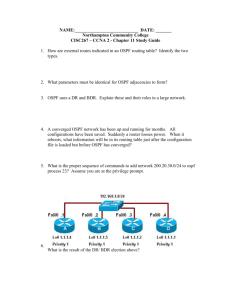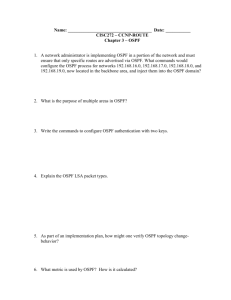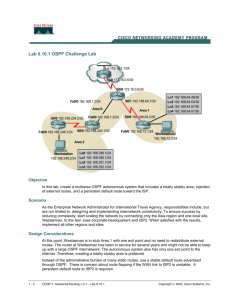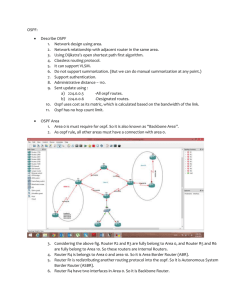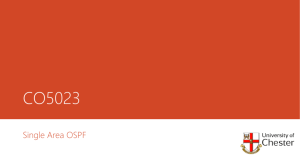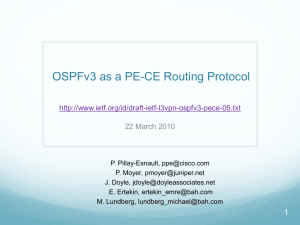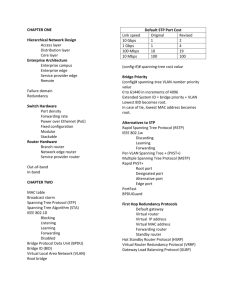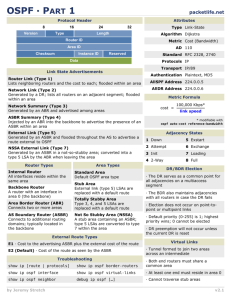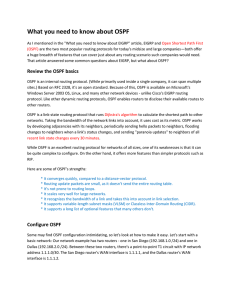1 - Aware
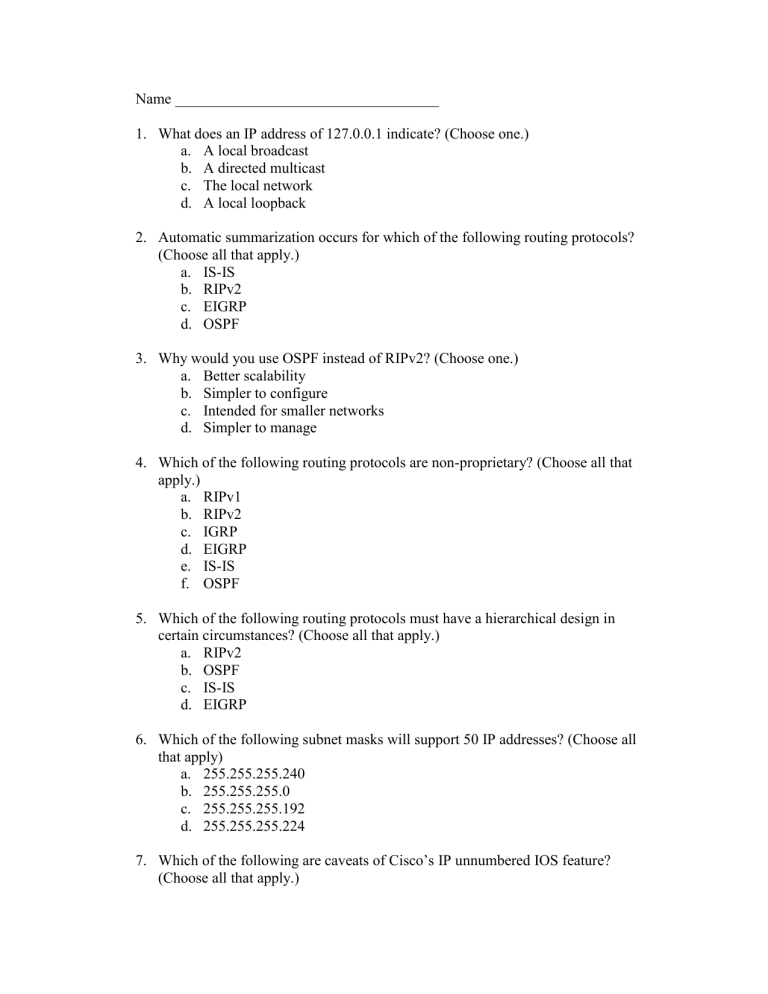
Name ___________________________________
1.
What does an IP address of 127.0.0.1 indicate? (Choose one.) a.
A local broadcast b.
A directed multicast c.
The local network d.
A local loopback
2.
Automatic summarization occurs for which of the following routing protocols?
(Choose all that apply.) a.
IS-IS b.
RIPv2 c.
EIGRP d.
OSPF
3.
Why would you use OSPF instead of RIPv2? (Choose one.) a.
Better scalability b.
Simpler to configure c.
Intended for smaller networks d.
Simpler to manage
4.
Which of the following routing protocols are non-proprietary? (Choose all that apply.) a.
RIPv1 b.
RIPv2 c.
IGRP d.
EIGRP e.
IS-IS f.
OSPF
5.
Which of the following routing protocols must have a hierarchical design in certain circumstances? (Choose all that apply.) a.
RIPv2 b.
OSPF c.
IS-IS d.
EIGRP
6.
Which of the following subnet masks will support 50 IP addresses? (Choose all that apply) a.
255.255.255.240 b.
255.255.255.0 c.
255.255.255.192 d.
255.255.255.224
7.
Which of the following are caveats of Cisco’s IP unnumbered IOS feature?
(Choose all that apply.)
a.
Does not work over HDLC networks. b.
Is not compatible with SNMP. c.
The unnumbered interface fails if its associated interface fails. d.
You cannot ping an unnumbered interface.
8.
If you decide not to use IP unnumbered on a serial link, to best preserve IP addresses, what should your subnet mask be? (Choose one.) a.
255.255.255.255 b.
255.255.255.0 c.
255.255.255.252 d.
255.255.252.0
9.
A router can determine that an IP address is part of a Class B network by examining the first two bits in the IP address. What are the first two bits for a class b network? (Choose one.) a.
00 b.
01 c.
10 d.
11
10.
Which of the following is a good design practice for implementing route summarization? (Choose one.) a.
Use primarily with discontiguous networks. b.
Use primarily with contiguous networks. c.
Do not use with VLSM. d.
Use with non-hierarchical addressing.
11.
Which of the following is a problem that NAT ad PAT are designed to address?
(Choose one.) a.
Assigning a DHCP address b.
Assigning an IP address to a border router c.
Translating non-routable IP addresses to legal routable IP addresses d.
Resolving IP address to full qualified domain names
12.
The command ip nat inside source static 10.1.3.2 200.4.2.5 is an example of which type of NAT translation? (Choose one.) a.
Static NAT b.
Dynamic NAT c.
Overlapping NAT d.
Overloading NAT
13.
Which IP address ranges were set aside by RFC 1918 for internal use only?
(Choose the two best answers.) a.
196.168.0.0/16 b.
172.16.0.0/12 c.
10.0.0.0/8
d.
172.16.0.0/16
14.
Which of the following best describes an inside network? (Choose one.) a.
The network of another company b.
The set of networks that are subject to IP translation c.
The side of the network using global addresses d.
The Internet
15.
Approximately how much memory on the NAT router is used for a single NAT translation? (Choose one.) a.
160 bytes b.
100KB c.
1MB d.
64 bytes
16.
What are benefits of using a link-state routing protocol? (Choose all that apply.) a.
It uses the Hello protocol to establish adjacencies. b.
It uses several components to calculate the metric of a route. c.
Updates are sent only when changes occur in the network. d.
It is a better protocol than distance-vector is.
17.
Which of the following are not features of EIGRP? (Choose all that apply.) a.
Incremental updates b.
Only one route per destination c.
Support for IP, IPX, and AT d.
Hybrid distance-vector and link-state routing protocol e.
Not a scalable protocol f.
Use of the Hello protocol to establish adjacencies
18.
Which of the following are used by EIGRP to calculate the best path to a destination network? (Choose all that apply.) a.
Bandwidth b.
Load c.
Delay d.
Reliability
19.
When sending EIGRP routes across a classful boundary, you notice that all of the routes are not appearing. What is going on, and how would you correct it so you could see all of the routes? (Choose one.) a.
The routes are being lost, and you need to troubleshoot the links involved. b.
Some of the routes’ advertised distances are not as good as the successor routes’ feasible distance so the routes are not being used. You need to manually decrease the advertised distance of the routes. c.
By default, EIGRP automatically summarizes routes at classful boundaries. In order for all of the routes to appear, you need to disable automatic summarization for EIGRP.
d.
Nothing is going on; no change is needed.
20.
Which command should be used to ensure proper metric conversion when redistributing routes from different protocols? (Choose one.) a.
distance distance-value b.
default-metric c.
distribute-list d.
default-information
21.
Which of the following is used first in the DR election process? (Choose one.) a.
Router ID b.
OSPF priority c.
The highest IP address d.
The lowest IP address
22.
Which of the following commands will display the networks on a device that are being routed by OSPF? (Choose one.) a.
show ip ospf neighbors b.
show ip ospf database c.
show ip route ospf d.
show ip protocol
23.
How many spanning tree instances are defines with the PVST protocol running on a switch with six VLANs configured? (Choose one.) a.
1005 b.
1 c.
6 d.
64
24.
You want to configure OSPF to operate in an NBMA environment over a Frame
Relay link. How would you accomplish this? (Choose one.) a.
Use point-to-multipoint on the physical interface. b.
Use point-to-point on the subinterfaces. c.
Use point-to-multipoint for a single subnet. d.
Use broadcast on the physical interface.
25.
You have configured OSPF in your network. Currently you have only one area.
You decide that it would be better to divide this single area into multiple areas.
What is this known as? (Choose one.) a.
Hierarchical routing b.
OSPF subarea c.
Area division d.
None of the above
26.
What is the IOS syntax to designate an area as a not-so-stubby area? (Choose one.)
a.
area area-id nssa b.
area area-id stub c.
area area-id no-summary d.
area area-id stub no-summary
27.
A router that has at least one interface in Area 0 is known as what type of OSPF router? (Choose one.) a.
Internal b.
Backbone c.
ABR d.
ASBR
28.
Which devices in a totally stubby are do you configure with the stub no-summary parameters? (Choose one.) a.
Internal b.
ABR c.
ASBR d.
All devices in the area
29.
Which IOS command shows information about a router’s OSPF database, such as router link states and network link states? (Choose one.) a.
debug ip ospf events b.
show ip ospf border-routers c.
show ip ospf neighbor d.
show ip ospf database
30.
Router1 is currently only in Area 0. You are going to add a new area known as
Area 1. You will need to add one of Router1’s interfaces to this new area. What type of OSPF router will Router1 be? (Choose one.) a.
Internal b.
ASBR c.
ABR d.
External

